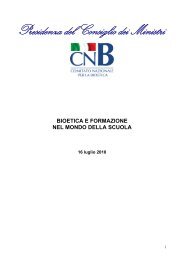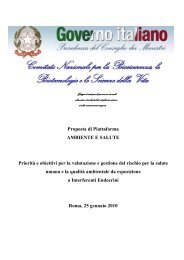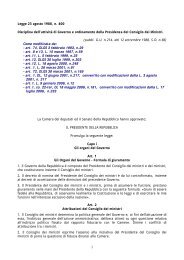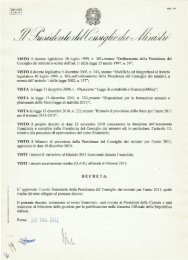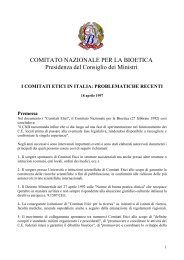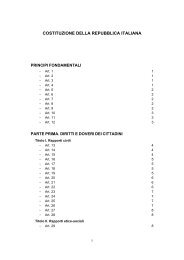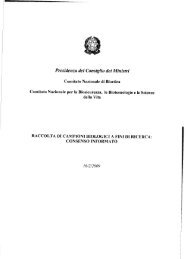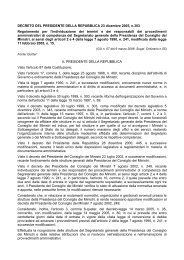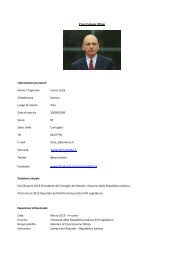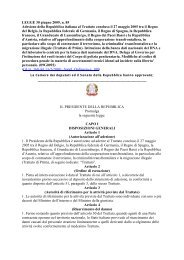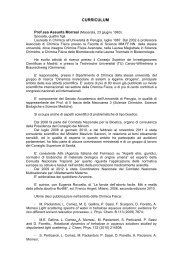President
President
President
You also want an ePaper? Increase the reach of your titles
YUMPU automatically turns print PDFs into web optimized ePapers that Google loves.
Only one published scientific paper reports a SCNT success in producing<br />
embryonic stem cells from hybrid embryos (Chen et al. Cell. Res. (2003).<br />
So far, neither the same research group nor any other one managed to<br />
successfully repeat that experiment. In the scientific literature we found out that<br />
many expressed doubts and criticisms towards that paper.<br />
On the New Scientist issue of 15th September, in an interview with Robert<br />
Lanza of Advanced Cell Technology, we read: "his company has made many<br />
unsuccessful attempts to produce embryonic stem cells from animal-human<br />
hybrids". They grow to the 16-cell stage, then just before going on to become<br />
blastocysts, they block," he says. Lanza thinks this happens because the<br />
mitochondrial genome of the animal "stops talking" to the human genome,<br />
blocking further growth.<br />
At this point, my question is: what is the scientific foundation of your<br />
experiment?<br />
Perhaps it is the expectation to attain better results due to having an<br />
unlimited number of available oocytes?<br />
If so, why is that the cloning of cows failed to yield any satisfactory result<br />
so far? Is your research project based upon any more solid scientific evidence?<br />
From which argument you infer that success, that is to say to produce<br />
hybrid cytoplasmatic embryos, is possible?<br />
Given that the mixing of DNA coming from different individuals belonging<br />
to the same species failed, how can it be possible to successfully do the same<br />
with individuals from different species?<br />
2. Your aim is to create "embryonic stem cell lines in order to determinate<br />
therapies for neurodegenerative illness".<br />
Many neurodegenerative illnesses are due to altered mitochondrial<br />
metabolism. Given this, how can you use a model for neurodegenerative illness<br />
in which mitochondrial metabolism is altered since its initial formation, and it is<br />
altered for causes other than those inducing the illness?<br />
3. In "Inter species embryos. A report by Academy of Medical Science",<br />
one reads: "In the context of cytoplasmatic hybrid embryos, the mitochondria<br />
and the cytoplasm represent potential sources of retrovirus within the animal<br />
oocyte. [...]. The nuclear genomes of cows and rabbits do contain endogenous<br />
retroviral genomes. It is therefore possible that rabbit or bovine oocyte<br />
cytoplasm may contain RNA transcripts or express endogenous retroviruses<br />
encoded by their nuclear genome. Such viruses might conceivably re-integrate<br />
into the transferred human nucleus. While this scenario is not impossible, on<br />
balance we consider it to be highly unlikely. To ascertain whether such a<br />
genuine problem, expression profiles for endogenous retroviruses could be<br />
sought for oocytes from potential recipient species".<br />
The authors specify that for these reasons, these cell lines should not be<br />
used for clinical treatment purposes. They also state that with standard<br />
laboratory procedures there shouldn't be any problem in this kind of research.<br />
The same problem was noted in several others auditions - oral and written<br />
- of the Science and Technology Committee.<br />
After the Creutzfeld-Jakob virus alarm, which originated in your country, I<br />
will be very surprised if Europeans institution will not ask for specific guarantees<br />
about these experiments. I'll be even more surprised if the ecological<br />
49




